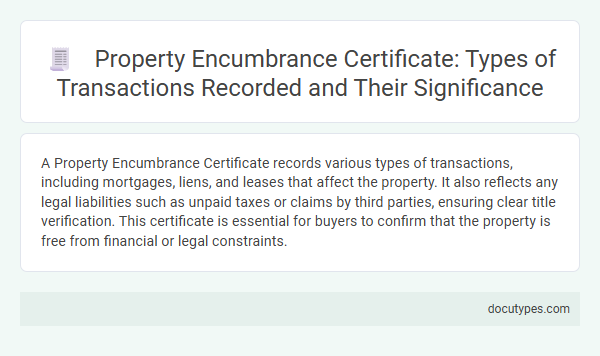A Property Encumbrance Certificate records various types of transactions, including mortgages, liens, and leases that affect the property. It also reflects any legal liabilities such as unpaid taxes or claims by third parties, ensuring clear title verification. This certificate is essential for buyers to confirm that the property is free from financial or legal constraints.
Introduction to Property Encumbrance Certificates
A Property Encumbrance Certificate (EC) is a critical legal document that provides details of all transactions and liabilities associated with a property. It helps buyers and lenders verify if a property is free from legal dues or encumbrances.
- Mortgage Details - Records any loans or mortgages registered against the property, indicating financial obligations.
- Sale and Purchase Transactions - Lists all previous ownership transfers, ensuring clear property title history.
- Lease and Agreement Entries - Includes any lease agreements or rights granted over the property that affect its usage.
What is an Encumbrance Certificate?
What is an Encumbrance Certificate in property transactions? An Encumbrance Certificate is a legal document that verifies whether a property is free from any monetary or legal liabilities. It records all transactions related to the property, such as sales, mortgages, and leases, ensuring transparency in ownership history.
Legal Importance of Encumbrance Certificates
Property encumbrance certificates record various types of transactions such as mortgages, liens, leases, and easements associated with a property. These transactions establish the legal standing of a property by highlighting any claims or liabilities that may affect ownership or transfer. The legal importance of encumbrance certificates lies in providing clear evidence of a property's free status from encumbrances, ensuring secure and transparent real estate dealings.
Types of Transactions Recorded in an Encumbrance Certificate
Property encumbrance certificates record various types of transactions that affect the legal standing of a property. These transactions include sale deeds, mortgage agreements, lease deeds, and lien registrations.
Encumbrance certificates also document any charges or liabilities, such as loans taken against the property or disputes related to ownership. This certificate serves as a crucial document to verify that the property is free from legal dues and claims before any transaction.
Sale Transactions in Encumbrance Certificates
| Transaction Type | Description | Relevance in Encumbrance Certificate |
|---|---|---|
| Sale Transactions | Transfers of property ownership from one party to another, documented through registered sale deeds. | Sale transactions are prominently recorded on the Property Encumbrance Certificate to indicate the history of ownership transfers. This helps verify that the property was sold without any unresolved liens or charges. |
| Mortgage Transactions | Transactions where the property is used as security for a loan, reflected by registered mortgage deeds. | Recorded to show any loans against the property which might impose a lien, affecting the property's encumbrance status. |
| Lease Transactions | Registered leases where the property is leased out for a specified duration. | Indicates any leasehold interests that might affect property ownership rights or valuation. |
| Gift Transactions | Transfer of property ownership without monetary exchange, via gift deeds. | Reflects ownership changes important for assessing the property's encumbrances. |
Sale transactions on a Property Encumbrance Certificate reveal crucial information about your property's ownership history and help confirm that no unpaid liabilities or disputes exist at the time of transfer.
Mortgage and Loan Entries
A Property Encumbrance Certificate records all financial liabilities and claims against a property. Mortgage and loan entries are prominently included to reflect any existing debts secured by the property. You can use this certificate to verify if the property has any outstanding mortgages or loans before proceeding with a transaction.
Lease and Gift Transactions
A Property Encumbrance Certificate records various transactions that affect the ownership and financial status of a property. Lease and gift transactions are two primary types documented to ensure clear title verification.
Lease transactions on the certificate detail the terms under which a property is rented, including the lease duration and parties involved. Gift transactions note the voluntary transfer of property ownership without monetary exchange, often listing donor and recipient information. These entries help verify encumbrances and confirm lawful possession or transfer rights.
Government Acquisitions and Notifications
A Property Encumbrance Certificate records various transactions affecting the legal title of a property, including government acquisitions and official notifications. This certificate ensures transparency about any claims or restrictions imposed on the property by government entities.
- Government Acquisition Entries - Details any acquisition of the property by government authorities for public use or development.
- Public Notifications - Includes government-issued notifications about zoning changes, land use restrictions, or compulsory purchases.
- Encumbrance Records - Lists liens, mortgages, or restrictions registered against the property by government agencies.
You can use this certificate to verify the absence of government claims or restrictions before completing any property transaction.
How Encumbrance Certificates Safeguard Buyers
Property Encumbrance Certificates (EC) record all financial transactions and claims related to a property, such as mortgages, leases, or legal liabilities. These certificates help verify the legal status of the property, protecting buyers from unforeseen encumbrances.
- Mortgage Transactions - Details of loans taken against the property are documented to reveal any outstanding debts.
- Legal Liens - Registered claims or lawsuits affecting the property are included to highlight potential disputes.
- Sale and Purchase Records - Previous transfers of ownership are noted to establish clear title history.
What Types of Transactions Are Entered on a Property Encumbrance Certificate? Infographic

